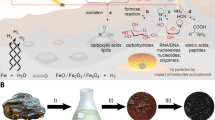Abstract
We demonstrated previously that Cr(VI) is readily reduced to oxoCr(V)-diols at the surface of Arthrobacter oxydans—a Gram-positive aerobic bacteria isolated from Columbia basalt rocks originated from a highly contaminated site in the USA. Here, we report an electron spin resonance (ESR) study of Cr(III) hydroxide formation from Cr(V)-diols by this bacterial strain as cells were exposed to 35, 200, and 400 mg/L of Cr(VI) under aerobic conditions as a batch culture and as lyophilized cells. The time-dependent ESR measurements show that the half-time of Cr(III) formation is almost equal to that of Cr(V) decomposition, which is in the range of 3–6 days for all cases. This rate is at least 300 times slower than that of Cr(V) formation. Additionally, atomic absorption spectrometry was also employed to examine the time course of total chromium in bacterial cells. This is the first time the kinetics of Cr(III) complexes formation in bacteria is evaluated.






Similar content being viewed by others
References
Appenroth KJ, Bischoff M, Gabrys H, Stoeckel J, Swartz HM, Walczak T, Winnefeld K (2000) Kinetics of chromium(V) formation and reduction in fronds of the duckweed Spirodela polyhriza—a low frequency EPR study. J Inorg Biochem 78:235–242
Asatiani NV, Abuladze MK, Kartvelishvili TG, Bakradze NG, Sapojnikova NA, Tsibakhashvili NY, Tabatadze L, Lejava L, Asanishvili LL, Holman HY (2004) Effect of chromium(VI) action on Arthrobacter oxydans. Curr Microbiol 49:321–326
Bartlett R, James BR (1988) Mobility and bioavailability of chromium in soils. Adv Environ Sci Technol 20:267–304
Beveridge TJ, Murray RGE (1980) Sites of metal deposition in the cell wall of Bacillus subtilis. J Bacteriol 141:876–887
Blake RC, Choate DM, Bardhan S, Revis N, Barton LL, Zocco TG (1993) Chemical transformation of toxic metals by a Pseudomonas strain from a toxic waste site. Environ Toxicol Chem 12:1365–1376
Chen JM, Hao OJ (1998) Microbial chromium (VI) reduction. Crit Rev Environ Sci Technol 28:219–251
Codd R, Dillon CT, Levina A, Lay PA (2001) Studies on the genotoxicity of chromium: from test tube to the cell. Coord Chem Rev 216–217:537–582
Codd R, Lay PA, Tsibakhashvili NY, Kalabegishvili TL, Murusidze IG, Holman HY (2006) Chromium(V) complexes generated in Arthrobacter oxydans by simulation analysis of EPR spectra. J Inorg Biochem 100:1827–1833
Daulton TL, Little BJ, Meehan JJ, Blom DA, Allard LF (2007) Microbial reduction of chromium from the hexavalent to divalent state. Geochim Cosmochim Acta 71:556–565
Fendorf SE (1995) Surface reactions of chromium in soils and waters. Geoderma 67:55–71
Holman HY, Perry D, Martin M, Lamble G, McKinney W, Hunter-Cevera J (1999) Real-time characterization of biogeochemical reduction of Cr(VI) on basalt surfaces by SR-FTIR imaging. Geomicrobiology J 16:307–324
Horitsu H, Futo S, Miyazawa Y, Ogai S, Kawai K (1987) Enzymatic reduction of hexavalent chromium by hexavalent chromium tolerant Pseudomonas ambigue G-1. Agric Biol Chem 51:2417–2420
Howe JA, Loeppert RH, Derose VJ, Hunter DB, Bertsch PM (2003) Localization and speciation of chromium in subterranean clover using XRF, XANES, and EPR spectroscopy. Environ Sci Technol 37:4091–4097
Ishibashi Y, Cervantes C, Silver S (1990) Chromium reduction in Pseudomonas putida. App Environ Microbiol 56:2268–2270
Kalabegishvili TL, Tsibakhashvili NY, Holman HY (2003) Electron spin resonance study of chromium(V) formation and decomposition by basalt-inhabiting bacteria. Environ Sci Technol 37:4678–4684
Kalabegishvili TL, Tsibakhashvili NY, Murusidze IG, Pataraya DT, Gurielidze MA, Holman HY (2006) Formation of Cr(V) and Cr)III) in Arthrobacter oxydans exposed to high concentrations of Cr(VI). In: Mendez-Vilas A (ed) Modern multidisciplinary applied microbiology. Wiley, Weinheim, pp 516–520
Liu KJ, Jiang J, Shi X (1995) Low-frequency EPR study of chromium(V) formation from chromium(VI) in living plants. Biochem Biophys Res Commun 206:829–834
McLean J, Beveridge TJ (2001) Chromate reduction by a pseudomonas isolated from a site contaminated with chromated copper arsenate. Appl Environ Microbiol 67:1076–1084
Mosulishvili LM, Kirkesali EI, Belokobilsky AI, Khizanishvili AI, Frontasyeva MV, Gundorina SF, Opera CD (2002) Epithermal neutron activation analysis of blue-green algae Spirulina platensis as a matrix for selenium-containing pharmaceuticals. J Radioanal Nucl Chem 252:15–20
Myers CR, Carstens BP, Antholine WE, Myers JM (2000) Chromium (VI) reductase activity is associated with the cytoplasmic membrane of anaerobically grown Shewanella putrefaciens MR-1. J Appl Microbiol 88:98–106
Nies DH (1999) Microbial heavy-metal resistance. Appl Microbiol Biotechnol 51:730–750
Priester JH, Olson SG, Webb SM, Neu MP, Hersman LE, Ve Holden PA (2006) Enhanced exopolymer production and chromium stabilization in Pseudomonas putida unsaturated biofilms. Appl Environ Microbiol 72:1988–1996
Puzon GJ, Roberts AG, Kramer DM, Xun L (2005) Formation of soluble organo-chromium(III) complexes after chromate reduction in the presence of cellular organics. Environ Sci Technol 39:2811–2817
Salzman G, Holz O (2002) The bacterial cell wall. Springer, Berlin, pp 211–217
Suzuki J, Banfield JF (2004) Resistance to, and accumulation of, uranium by bacteria from a uranium-contaminated site. Geomicrobiology J 21:113–121
Tsibakhashvili NY, Kalabegishvili TL, Rcheulishvili AN, Murusidze IG, Pataraya DT, Gurielidze MA, Holman HY (2006) Detoxification of Cr(VI) by basalt-inhabiting bacteria. In: Gidarakos E, Nikoladis N (eds) Proceedings of the International Conference—Protection and Restoration of the Environment VIII. Chania, Crete, Greece, pp 115–116
Wang PC, Mori T, Toda K, Ohtake I (1990) Membrane-associated chromate reductase activity from Enterobacter. J Bacteriol 172:1670–1672
Lin Z, Zhu Y, Kalabegishvili TL, Tsibakhashvili NY, Holman HY (2006) Effect of chromate action on morphology of basalt-inhabiting bacteria. Mater Sci Eng C 26:610–612
Acknowledgments
This work was funded by Grant #STCU-GNSF 4330/131 from the Ukrainian Science and Technology Centre (STCU) and Georgian National Science Foundation (GNSF). The participation at the BioMicroWorld2007 was financed by the GNSF Travel Grant #TR07/82. We gratefully acknowledge Prof. D. Pataraya for providing bacterial samples and Miss L. Asanishvili for her assistance during AAS experiments.
Author information
Authors and Affiliations
Corresponding author
Rights and permissions
About this article
Cite this article
Tsibakhashvili, N.Y., Kalabegishvili, T.L., Rcheulishvili, A.N. et al. Decomposition of Cr(V)-diols to Cr(III) Complexes by Arthrobacter oxydans . Microb Ecol 57, 360–366 (2009). https://doi.org/10.1007/s00248-008-9476-6
Received:
Accepted:
Published:
Issue Date:
DOI: https://doi.org/10.1007/s00248-008-9476-6




